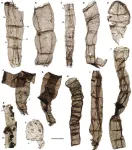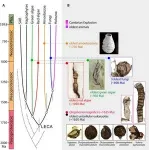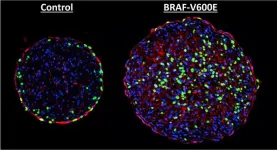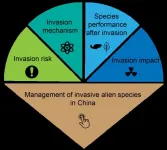(Press-News.org) In a study published in Science Advances on Jan. 24, researchers led by Prof. ZHU Maoyan from the Nanjing Institute of Geology and Palaeontology of the Chinese Academy of Sciences reported their recent discovery of 1.63-billion-year-old multicellular fossils from North China.
These exquisitely preserved microfossils are currently considered the oldest record of multicellular eukaryotes. This study is another breakthrough after the researchers’ earlier discovery of decimeter-sized eukaryotic fossils in the Yanshan area of North China, and pushes back the emergence of multicellularity in eukaryotes by about 70 million years.
All complex life on Earth, including diverse animals, land plants, macroscopic fungi, and seaweeds, are multicellular eukaryotes. Multicellularity is key to eukaryotes acquiring organismal complexity and large size, and is often regarded as a major transition in the history of life on Earth. However, scientists have been unsure when eukaryotes evolved this innovation.
Fossil records offering convincing evidence show that eukaryotes with simple multicellularity, such as red and green algae, and putative fungi, appeared as early as 1.05 billion years ago. Older records have claimed to be multicellular eukaryotes, but most of them are controversial because of their simple morphology and lack of cellular structure.
"The newly discovered multicellular fossils come from the late Paleoproterozoic Chuanlinggou Formation that is about 1,635 million years old. They are unbranched, uniseriate filaments composed of two to more than 20 large cylindrical or barrel-shaped cells with diameters of 20–194 μm and incomplete lengths up to 860 μm. These filaments show a certain degree of complexity based on their morphological variation," said MIAO Lanyun, one of the researchers.
The filaments are constant, or tapered throughout their length, or tapered only at one end. Morphometric analyses demonstrate their morphological continuity, suggesting they represent a single biological species rather than discrete species. The fossils have been named Qingshania magnifica, 1989, a form taxon with similar morphology and size, and are described as being from the Chuanlinggou Formation.
A particularly important feature of Qingshania is the round intracellular structure (diameter 15–20 μm) in some cells. These structures are comparable to the asexual spores known in many eukaryotic algae, indicating that Qingshania probably reproduced by spores.
In modern life, uniseriate filaments are common in both prokaryotes (bacteria and archaea) and eukaryotes. The combination of large cell size, wide range of filament diameter, morphological variation, and intracellular spores demonstrate the eukaryotic affinity of Qingshania, as no known prokaryotes are so complex. Filamentous prokaryotes are generally very small, about 1–3 μm in diameter, and are distributed across more than 147 genera of 12 phyla. Some cyanobacteria and sulfur bacteria can reach large sizes, up to 200 μm thick, but these large prokaryotes are very simple in morphology, with disc-shaped cells, and are not reproduced by spores.
The best modern analogues are some green algae, although filaments also occur in other groups of eukaryotic algae (e.g., red algae, brown algae, yellow algae, charophytes, etc.), as well as in fungi and oomycetes.
"This indicates that Qingshania was most likely photosynthetic algae, probably belonging to the extinct stem group of Archaeplastids (a major group consisting of red algae, green algae and land plants, as well as glaucophytes), although its exact affinity is still unclear," said MIAO.
In addition, the researchers conducted Raman spectroscopic investigation to test the eukaryotic affinity of Qingshania from the perspective of chemical composition, using three cyanobacterial taxa for comparison. Raman spectra revealed two broad peaks characteristic of disordered carbonaceous matter. Furthermore, the estimated burial temperatures using Raman parameters ranged from 205–250 °C, indicating a low degree of metamorphism. Principal component analysis of the Raman spectra sorted Qingshania and the cyanobacterial taxa into two distinct clusters, indicating that carbonaceous matter of Qingshania is different from that of cyanobacterial fossils, further supporting the eukaryotic affinity of Qingshania.
Currently, the oldest unambiguous eukaryotic fossils are unicellular forms from late Paleoproterozoic sediments (~1.65 billion years ago) in Northern China and Northern Australia. Qingshania appeared only slightly later than these unicellular forms, indicating that eukaryotes acquired simple multicellularity very early in their evolutionary history.
Since eukaryotic algae (Archaeplastids) arose after the last eukaryotic common ancestor (LECA), the discovery of Qingshania, if truly algal in nature, further supports the early appearance of LECA in the late Paleoproterozoic—which is consistent with many molecular clock studies—rather than in the late Mesoproterozoic of about 1 billion years ago.
This study was funded by the National Key Research and Development Program of China, the National Natural Science Foundation of China, and the Innovation Cross-Team of CAS.
END
North China fossils show eukaryotes first acquired multicellularity 1.63 billion years ago
2024-01-24
ELSE PRESS RELEASES FROM THIS DATE:
Harnessing skin cancer genes to heal hearts
2024-01-24
DURHAM, N.C. – Biomedical engineers at Duke University have demonstrated that one of the most dangerous mutations found in skin cancers might moonlight as a pathway to mending a broken heart.
The genetic mutation in the protein BRAF, a part of the MAPK signaling pathway that can promote cell division, is one of the most common and most aggressive found in melanoma patients. In a new study, researchers show that introducing this mutation to rat heart tissue grown in a laboratory can induce growth.
Repairing ...
Special Feature calls attention to biological invasion research in China
2024-01-24
This month, the Ecological Society of America spotlights the challenge posed by invasive alien species in China with the release of a Special Feature, “Management of Biological Invasions in China,” in the latest issue of its journal Ecological Applications.
Accelerating rates of biological invasion have led to growing concerns about the destructive impacts of invasive alien species, or IAS, on the environment and human societies. This is especially true in China, which has witnessed a surge in ...
Researchers add a ‘twist’ to classical material design
2024-01-24
Researchers with the Department of Energy’s SLAC National Accelerator Laboratory, Stanford University and the DOE's Lawrence Berkeley National Laboratory (LBNL) grew a twisted multilayer crystal structure for the first time and measured the structure’s key properties. The twisted structure could help researchers develop next-generation materials for solar cells, quantum computers, lasers and other devices.
“This structure is something that we have not seen before – it was a huge surprise to me,” said Yi Cui, a professor at Stanford and SLAC and paper co-author. “A new quantum electronic property could appear ...
The costly, unintended consequences produced by the National Flood Insurance Program
2024-01-24
Since the creation of the National Flood Insurance Program (NFIP) in 1968, the U.S. government has paid over $51 billion to cover flood losses. Almost half of these payouts went to just 25 counties, among the fastest-growing counties by population. A new paper published in the Journal of the Association of Environmental and Resource Economists examines whether insuring people against potential flood losses contributes directly to population growth in flood-prone areas. In “Does the National Flood Insurance Program Drive Migration ...
Tiny vibrating bubbles could lead to better water treatment
2024-01-24
Fresh research into the physics of vibrating nanobubbles reveals that they do not heat up as much as previously thought.
Vibrating nanobubbles have surprising uses as ultrasound contrast agents in cancer diagnosis. They can also be forced to collapse - destroying nearby microscopic contaminants - for waste-water treatment and surface cleaning of delicate microfluidic devices.
The stiffness of a nanobubble as it vibrates is strongly related to their internal temperature, and being able to understand ...
Self-powered movable seawall for tsunami protection and emergency power generation
2024-01-24
With over 2,780 fishing ports and 993 commercial and industrial ports, Japan faces the challenge of safeguarding these important coastal assets from the destructive forces of tsunamis. A promising solution lies in the form of a movable barrier system, where gates rising from the seafloor act as barriers, protecting ports against tsunamis, storm surges and high waves. However, during natural disasters, power outages may disrupt the electricity needed to operate the gate.
To address this, researchers led by Professor Hiroshi Takagi from Tokyo Institute of Technology have proposed ...
Groundwater levels are sinking ever faster around the world
2024-01-24
At the beginning of November, The New York Times ran the headline, “America is using up its groundwater like there’s no tomorrow.” The journalists from the renowned media outlet had published an investigation into the state of groundwater reserves in the United States. They came to the conclusion that the United States is pumping out too much groundwater.
But the US isn’t an isolated case. “The rest of the world is also squandering groundwater like there’s no tomorrow,” says Hansjörg Seybold, Senior Scientist in the Department of Environmental Systems Science at ETH Zurich. He is coauthor ...
$1.2 million grant awarded to LSU LCMC Health Cancer Center to help break down barriers to cervical cancer prevention
2024-01-24
NEW ORLEANS (Jan. 24, 2024) – A research team from LSU LCMC Health Cancer Center has been awarded a $1.5 million grant to eliminate barriers from cervical cancer prevention. The five-year program combines a $1.2 million award from the American Cancer Society and $75,000 a year for five years investment from LSU Health New Orleans.
Louisiana has one of the highest cervical cancer death rates in the country. Cervical cancer rates are higher in predominantly African American communities represented in both urban (New Orleans) and rural areas of Louisiana. Black women in Louisiana are diagnosed with and die from cervical cancer at a significantly ...
Off-road autonomy: U-M's Automotive Research Center funded with $100 million through 2028
2024-01-24
Images
The U.S. Army has extended its long-running relationship with the University of Michigan's Automotive Research Center, reaching a new five-year, agreement of up to $100 million to boost work on autonomous vehicle technologies.
This potentially doubles the federal government's financial investment with ARC since the last agreement, reached in 2019. Following its 1994 launch, the ARC has served as a source of technology and first-in-class modeling and simulation for the Army's fleet of vehicles—the largest such fleet in the world.
"We are driving the development of modern mobility systems with our advanced modeling ...
Atmospheric pressure changes could be driving Mars’ elusive methane pulses
2024-01-24
New research shows that atmospheric pressure fluctuations that pull gases up from underground could be responsible for releasing subsurface methane into Mars’ atmosphere; knowing when and where to look for methane can help the Curiosity rover search for signs of life.
“Understanding Mars’ methane variations has been highlighted by NASA’s Curiosity team as the next key step towards figuring out where it comes from,” said John Ortiz, a graduate student at Los Alamos National Laboratory who led the research team. “There are several challenges associated with meeting that goal, ...






